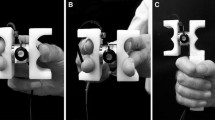Summary
The coordination of manipulative forces was examined while children and adults repeatedly lifted a small object between the thumb and index finger. Grip force, load force (vertical lifting force), grip force rate and the vertical position of the test object were continuously measured. In adults, the force generation was highly automatized and was nearly invariant between trials. After a preload phase in which the grip was established, the grip and load forces increased in parallel under isometric conditions until the load force overcame the force of gravity and the object started to move. During this loading phase, the force rate profiles were essentially bell shaped and single peaked, suggesting that the force increases were programmed as one coordinated event. Children below the age of two exhibited a prolonged preload phase and a loading phase during which the grip and load forces did not increase in parallel. A major increase in grip force preceded the increase in load force, and at the start of the loading phase, the grip force was usually several Newtons (N). The force rate profiles were multi peaked with step-wise force increases most likely allowing peripheral feedback to play an important role in the control of the forces. After the age of two, the grip force increased less during the preload phase. The loading phase was more regularly characterized by a parallel increase of the grip force and load force and the duration of the various phases decreased. The older children programmed the forces in one force rate pulse indicating the emergence of an anticipatory strategy. Yet, the mature coordination of forces was not fully developed until several years later. It was concluded that the development of the precision grip was based upon the formation of a lift synergy coupling grip and load force generating circuits and that it seems to involve a transition from feedback control to feedforward control.
Similar content being viewed by others
References
Bernstein N (1967) The coordination and regulation of movements. Pergamon, Oxford
Brooks VB (1984) How are “move” and “hold” programs matched. In: Bloedel et al (ed) Cerebellar functions. Springer, Berlin, pp 1–23
Connolly KJ, Elliott J (1962) The evolution and ontogeny of hand function. In: Blurton-Jones C (eds) Etiological studies of child behavior. University Press, Cambridge, pp 329–383
Fetz EE, Cheney PD (1980) Post-spike facilitation of forelimb muscle activity by primate corticomotoneural cells. J Neuro physiol. 44: 751–772
Gelfand IM, Gurfinkel VS, Tsetlin ML, Shik ML (1971) Some problems in the analysis of movements. In: Gelfand IM, Gurfinkel VS, Fomin S, Tsetlin ML (eds) Models of the structural functional organization of certain biological systems. MIT Press, Cambridge Mass, pp 329–345
Gordon AM, Forssberg H, Johansson RS, Westling G (1991) The integration of haptically acquired size in the programming of the precision grip. Exp Brain Res 83: 483–488
Halverson HM (1931) Study of prehension in infants. Genet Psychol Mon 10: 110–286
Hofsten C von, Rönnquist L (1988) Preparation for grasping an object: developmental study. J Exp Psychol Hum Percept: 14: 610–621
Illingworth RS (1975) The development of the infant and young child: normal and abnormal. Churchill Livingstone, Edinburgh London New York
Issler H, Stephens JA (1983) The maturation of cutaneous reflexes studied in the upper limb in man. J Physiol 335: 643–654
Jeannerod M (1984) The timing of natural prehension movements. J Motor Behav 16: 235–254
Johansson RS, Westling G (1984) Roles of glabrous skin receptors and sensorimotor memory in automatic control of precision grip when lifting rougher or more slippery objects. Exp Brain Res 56: 550–564
Johansson RS, Westling G (1988) Coordinated isometric muscle commands adequately and erroneously programmed for the weight during lifting task with precision grip. Exp Brain Res 71: 59–71
Johansson RS, Westling G (1990) Tactile afferent signals in the control of precision grip. In: Jeannerod M (ed) Attention and performance, Vol XIII. Erlbaum, Hillsdale NJ, pp 677–713
Johansson RS (1990) How is grasping modified by somatosensory input? In: Humphrey DR Freund HJ (eds) Motor control: concepts and issues (Dahlem Konferenzen). John Wiley & Sons Ltd, Chichester, pp 331–355
Lawrence DG, Hopkins DA (1976) The development of motor control in the rhesus monkey: evidence concerning the role of corticomotoneuronal connections. Brain 99: 235–254
Lawrence DG, Kuypers HGJM (1968) The functional organization of the motor system in the monkey. I. The effects of bilateral pyramidal lesions. Brain 91: 1–14
Muir RB, Lemon RN (1983) Corticospinal neurons with a special role in precision grip. Brain 261: 312–316
Napier JR (1956) The prehensile movement of human hand. J Bone Joint Surg 38B:4: 902–913
Passingham R, Perry H, Wilkinson F (1978) Failure to develop a precision grip in monkeys with unilateral neocortical lesions made in infancy. Brain Res 145: 410–414
Peiper A (1963) Cerebral function in infancy and childhood. Consultants Bureau, New York
Turvey MT, Shaw RE, Mace W (1978) Issues in the theory of action: degrees of freedom, coordinative structures and coalitions. In: Requin J, Hillsdale NJ (eds) Attention and performance, VII. Erlbaum, pp 557–595
Twitchell T (1970) Reflex mechanisms and the development of prehension. In: Connolly K (ed) Mechanisms of motor skill development. Academic Press, New York, pp 25–45
Westling G, Johansson RS (1984) Factors influencing the force control during precision grip. Exp Brain Res 53: 277–284
Westling G, Johansson RS (1987) Responses in glabrous skin mechanoreceptors during precision grip in humans. Exp Brain Res 66: 128–140
Author information
Authors and Affiliations
Rights and permissions
About this article
Cite this article
Forssberg, H., Eliasson, A.C., Kinoshita, H. et al. Development of human precision grip I: Basic coordination of force. Exp Brain Res 85, 451–457 (1991). https://doi.org/10.1007/BF00229422
Received:
Accepted:
Issue Date:
DOI: https://doi.org/10.1007/BF00229422




